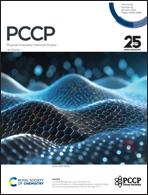TMAO perturbs intermolecular vibrational motions of water revealed by low-frequency modes†
Abstract
Trimethylamine N-oxide (TMAO) as a representative natural osmolyte has received much attention because of its unique properties, including enhancement of hydrogen bonding networks in liquid water and stabilization of three-dimensional structures of proteins in living organisms. As a hydrogen bond maker and/or a protein stabilizer, its hydrated structures and orientation dynamics in aqueous solutions have been investigated by various spectroscopic methods. Particularly, distinct from other natural osmolytes, it has been found that TMAO molecules form complexes with water molecules even at low concentrations, showing extraordinarily long lifetimes and much larger effective dipole moments. In this study, we demonstrated that collective motions of water molecules are closely correlated to TMAO molecules, as revealed by the changes of the librational modes observed in hyper-Raman (HR) spectra in the low-frequency region (<1000 cm−1) for the first time. Based on HR spectra of the TMAO solutions at submolar concentrations, we observed that the librational bands originating from water apparently upshift (∼15 cm−1) upon the addition of TMAO molecules. Compared to the OH stretching band of water showing a negligible downshift (<5 cm−1), the librational bands of water are more sensitive to reflect changes in the hydrogen bonding networks in the TMAO solutions, suggesting formation of transient TMAO–water complexes plays an essential role toward surrounding water molecules in perturbing their librational motions. We expect to provide a supplementary approach to understand that water molecules in TMAO aqueous solutions are strongly affected by TMAO molecules, different from other osmolytes.

- This article is part of the themed collection: 2024 PCCP HOT Articles


 Please wait while we load your content...
Please wait while we load your content...